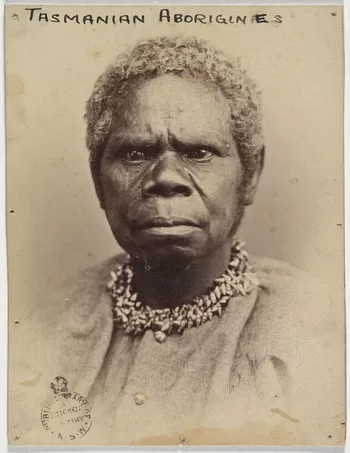The State Library of New South Wales has launched a groundbreaking exhibition within its newly unveiled underground Photography Gallery. This remarkable showcase, appropriately called “Shot,” represents the library’s most extensive and noteworthy photographic exhibition to date, and it is now accessible to the public.
The State Library of New South Wales (SLNSW) is home to a comprehensive and varied photography collection, widely recognized as one of Australia’s most important. This collection encompasses a broad spectrum of photographic materials, ranging from the earliest days of photography to contemporary masterpieces.
With an expansive collection of two million images in the State Library to choose from, the inaugural exhibition “Shot” offers a visual journey through 400 captivating moments captured by 200 photographers spanning three centuries. Many of these images are being presented for the first time.
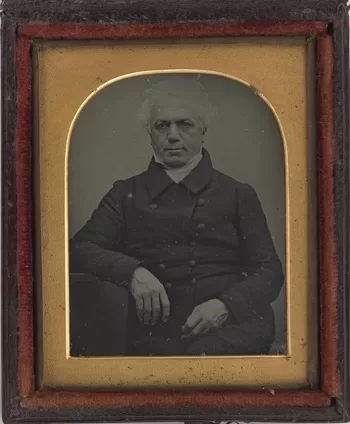

Australia’s oldest surviving photograph
Situated beneath the Library’s historic Mitchell building, the gallery boasts an innovative transparent design that highlights the photographs as original artifacts, commencing with Australia’s oldest surviving photograph, an 1845 daguerreotype portrait of Dr. William Bland, created by George Baron Goodman, Australia’s first professional photographer.
The exhibition guides visitors through the decades. Senior Curator Geoff Barker invested two years exploring the Library’s remarkable and diverse collection, unearthing surprising finds. He elaborates:
“The images are arranged into decades like a time tunnel, which allows the collection to tell its own story”
“Visitors will see things like fashion, architecture and transport, as well as photographic styles and printing processes, change over time.”
Senior Curator Geoff Barker.
Photo-crayotype, 1859 by Edwin Dalton
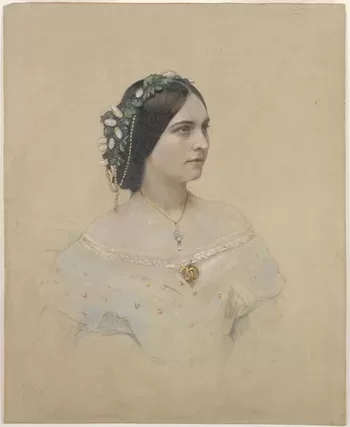

Photo-crayotypes, also known as Chromatypes and Crayon Collotypes, were a creative method employed for hand-coloring photographs by applying crayons and pigments to photographic impressions.
On August 29, 1857, three consecutive advertisements promoted photographs hand-painted with crayons, oils, or water colors.
The last of these advertisements was by Edward Dalton, who encouraged Sydneysiders to acquire his “Collodion Portraits,” believing they possessed the delicacy and clarity of mezzotint engravings and, when colored, exhibited the finesse and brilliance of miniature ivory portraits.
DALTON’S COLLODION PORTRAITS, coloured and uncoloured.-These portraits (the Collodion) have quite superseded the Daguerreotype. They represent nature in a more pleasing and truthful aspect ; the uncoloured having all the delicacy and clearness of mezzotint engravings, whilst the coloured possess the finish and brilliancy of miniatures upon ivory. Mr. DALTON (late instructor and painter to the Queen), 243, George-street
advertisements was by Edward Dalton
While Dalton’s colored photos likely had distinctions from the photo-crayotype he claimed to have invented in 1858, the advertisements make it clear that Australian photographers used collodion plates as the foundation for their images. This is noteworthy because it indicates their departure from William Henry Fox Talbot’s “calotype” process, which relied on paper negatives as the basis for salt paper prints.
On December 8, 1858, Edward Dalton exhibited “photo-crayotypes,” which he asserted were produced using a process of his own invention. Dalton’s ‘photo-crayotypes’ were similar to other processes which used photography as the base from which to overpaint with crayons, pencils, watercolours and oil paint
Truganini, 1866 by Charles Woolley
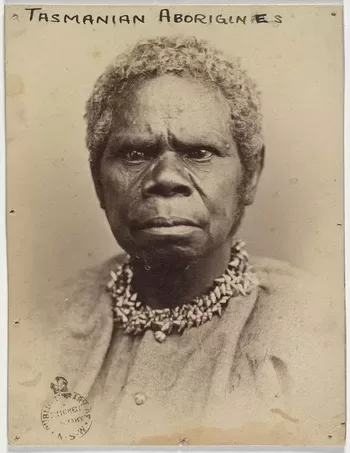

Truganini, the daughter of the leader of the Bruny Island people, endured The Black Wars that unfolded alongside European settlement in Tasmania.
Her life serves as an emblematic narrative of colonial interactions in Tasmania, encapsulating the collision of two distinct cultures and the enduring resilience of the indigenous Tasmanians in the face of these challenges.
Charles Alfred Woolley (1834-1922), a photographer and illustrator, operated a studio on Macquarie Street in Hobart from 1859 to 1870.
During this period, he produced a wealth of portraits, as well as images and stereographs showcasing Hobart and its environs. However, his most enduring legacy lies in his photographic documentation of the Oyster Cove Aborigines, including notable figures like Truganini and William Lanne.
These photographs were captured in August 1866 and subsequently exhibited at the Intercolonial Exhibition in Melbourne later that year. Engravings based on these images were later featured in publications and exhibited by Woolley again in the 1870s. Multiple sets of these prints have survived, some of which are held in anthropological collections in London and Oxford. In Australia, Woolley’s work is well-represented in various collections, including the National Library and the State Libraries of New South Wales, Tasmania, and Victoria.
Ned Kelly by Charles Nettleton
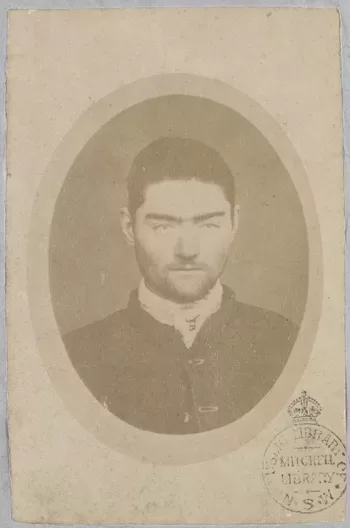

Ned Kelly, 1874 attributed to Charles Nettleton, albumen print. This photograph was organised by prison authorities at the end of bushranger Ned Kelly’s second jail sentence in 1874 for horse theft. (Kelly was in Beechworth Gaol when the horse was taken, so the charge was downgraded to “feloniously receiving a horse”).
After being captured at the infamous siege of Glenrowan, Kelly was hanged 11 November 1880.
Charles Nettleton (1826-1902) was a photographer who came from England to Victoria in 1854. He joined the Melbourne photography studio of T. Duryea and Alexander McDonald, where he specialized in outdoor photography.
Nettleton carried his darkroom tent and equipment with him at all times, which was essential during the collodion process era, as plates needed immediate development after exposure.
He was the official photographer for the government and the Melbourne Corporation. Notably, he is credited with capturing an image of the first Australian steam train when the private Melbourne-Sandridge (Port Melbourne) railway line was inaugurated on September 12, 1854.
Garden Palace, Sydney, 1880
The Garden Palace was an expansive, custom-built exhibition structure erected to host the Sydney International Exhibition of 1879 in Sydney, Australia. Tragically, in 1882, it was entirely consumed by a devastating fire.
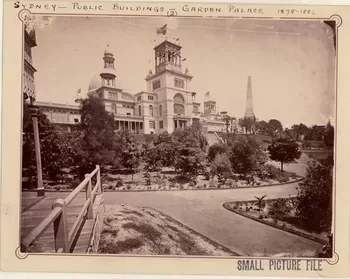

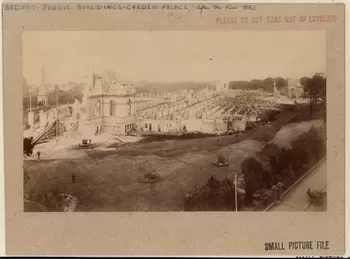

Ruins of the Garden Palace, 1882 by an unknown photographer. Images were taken just 2 years apart show the Garden Palace in its glory and its ruin.
Inspired by London’s Crystal Palace, the Garden Palace was designed with a layout reminiscent of a grand cathedral. It featured a lengthy hall flanked by lower aisles on both sides, akin to a nave, and a transept with a comparable structure, culminating in towers and converging under a central dome. The dome was 100 feet (30 metres) in diameter and 210 feet (64 metres) in height. The building was over 244 metres long.
The extensive use of timber in its construction proved catastrophic, resulting in its total obliteration when it was consumed by fire in the early hours of September 22, 1882. Between 500 and 1000 pieces of Sydney Aboriginal artefacts were lost in this fire, along with records of the squattocracy.
The Garden Palace was located at the present-day southwestern tip of the Royal Botanic Garden. The sole surviving remnants of the Garden Palace are the intricately carved gateposts made from Sydney sandstone and the wrought iron gates. They are situated at the entrance on Macquarie Street, providing access to the Royal Botanical Garden.
Dog ride by Walter Burke
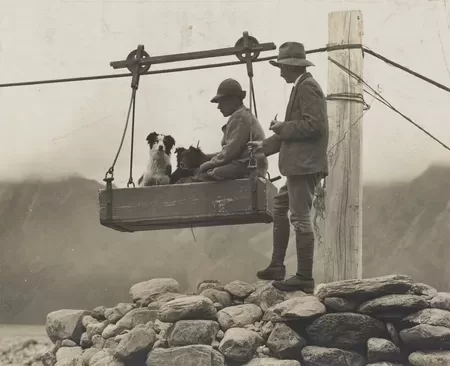

Walter Burke held the editorial position at the Australasian Photo-Review for over four decades. During the 1890s, he worked as a photographer for the Christchurch Weekly. The photograph in question likely dates back to this period, capturing one of his excursions with his half-plate camera.
In 1904, he relocated to Sydney, where he set up the Australasian branch of the American photography company, Underwood and Underwood, producers of stereoscopic and other photographic images, and pioneers in the field of news bureau photography.
Walter Burke had the distinction of becoming the inaugural fellow of the Royal Photographic Society in Australasia.
20th century “Shots”
This page highlights some of the 19th century photos in the State Library of NSW’s Shots exhibition. The next page includes some of the very best Australian 20th century photographers and photographs.
“Shot” is a free exhibition showcased in the State Library’s new Photography Gallery and will be open to the public until October 20, 2024. You can find more information here.
State Library of New South Wales photography collection
The State Library of New South Wales (SLNSW) houses an extensive and diverse photography collection that is considered one of the most significant in Australia. This collection includes a wide range of photographic materials, spanning from the earliest days of photography to contemporary works. Some key features of the photography collection at SLNSW include:
Historical Photographs: The collection contains a vast array of historical photographs, including daguerreotypes, ambrotypes, and tintypes from the 19th century. These early photographic formats provide valuable insights into the history and people of New South Wales and Australia.
Photographic Archives: SLNSW holds numerous photographic archives and collections from renowned Australian photographers, as well as commercial studios, which have documented various aspects of Australian life over the years.
Pictorial Collections: The library’s pictorial collections feature photographs from different periods and styles, illustrating the history, culture, and landscapes of New South Wales and Australia.
Contemporary Photography: The collection also includes contemporary photographic works, showcasing the creative and artistic contributions of modern photographers.
Special Exhibitions: SLNSW regularly hosts special photography exhibitions that highlight specific themes, photographers, or historical periods, allowing visitors to explore and appreciate the visual history of New South Wales and Australia.
Digital Collections: The library has digitized a significant portion of its photography collection, making it accessible to a global audience through its online platforms.
The State Library of New South Wales has a dedicated team of curators and archivists who work to preserve, catalog, and provide access to these photographic materials.
Researchers, historians, artists, and the general public can access the photography collection for study, research, and appreciation of the rich visual history of New South Wales and Australia. The library’s website provides information on accessing and exploring its photography collections online or in person.
State Library of New South Wales
The State Library of New South Wales is a major library and cultural institution located in Sydney, Australia. It is the oldest library in Australia, established in 1826, and it serves as the primary reference and research library for the state of New South Wales.
The library’s mission is to collect, preserve, and provide access to a wide range of materials and resources, including books, manuscripts, maps, photographs, and digital content, to support research, learning, and the cultural heritage of the state.
The State Library of New South Wales offers a vast collection of resources for researchers, scholars, and the general public, covering a wide range of subjects, with a particular emphasis on materials related to the history and culture of New South Wales and Australia.
It also hosts various exhibitions, events, and educational programs to promote cultural and intellectual engagement.
The library is located in a historic building in the central business district of Sydney and is a prominent cultural institution in the city and the state. It provides a valuable resource for those seeking information about the history, culture, and heritage of New South Wales and Australia.
Related stories
The first photograph taken in Australia was by Captain Lucas
The oldest surviving Daguerreotype in Australia, 1845
Australia’s first professional photographer George B Goodman
10 important photography exhibitions in Australia
Louis Daguerre and the invention of the daguerreotype
The beginning of photography: heliographs and daguerreotypes
Photography: Real & Imagined at National Gallery of Victoria

